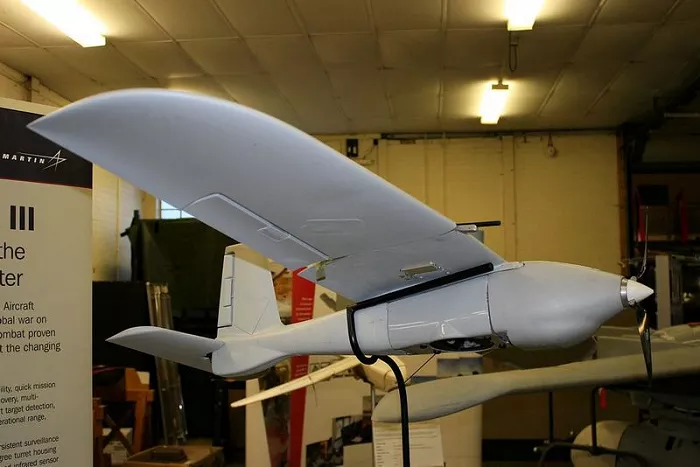The Lockheed Martin Desert Hawk III (DHIII) is a small, hand-launched unmanned aerial vehicle (UAV) designed for military reconnaissance and surveillance. Developed by Lockheed Martin’s Skunk Works team, the DHIII is lightweight, quiet, and easy to operate, making it ideal for tactical missions in challenging environments. It has been widely used by the British Army and other allied forces for intelligence gathering and battlefield awareness.
Design and Development
The Desert Hawk III was introduced in 2006 as an upgrade to the original Desert Hawk, which first flew in 2003. The DHIII features a more efficient design, allowing it to stay airborne for over 30 minutes longer than its predecessor. Constructed from polypropylene, a flexible and durable plastic, the DHIII can withstand rough handling and harsh conditions. Its electric motor powers a quiet propeller, enabling stealthy operations close to targets.
Specifications
- Weight: 8 lbs (3.6 kg)
- Wingspan: 4.3 ft (1.3 m)
- Endurance: Up to 90 minutes
- Range: 15 km (9.3 miles)
- Service Ceiling: 1,000 ft (304 m)
- Powerplant: Electric propulsion system
Sensors and Payloads
The DHIII is equipped with advanced sensors for various mission requirements. Its modular design allows for quick swapping of payloads, enhancing mission flexibility. Key sensor options include:
- Electro-Optical (EO) Camera: Captures high-resolution images and video.
- Infrared (IR) Sensor: Detects heat signatures for night operations.
- Long Wave Infrared (LWIR) Imager: Provides thermal imaging to identify heat differences.
- Laser Illuminator: Enhances night vision capabilities.
- Synthetic Aperture Radar (SAR): Generates detailed images in all weather conditions.
- Signals Intelligence (SIGINT): Intercepts electronic signals for analysis.
- Communications Intelligence (COMINT): Monitors communication signals to determine their origin and duration.
Notably, the DHIII was the first small UAV to feature a 360-degree infrared sensor, providing comprehensive situational awareness during night operations.
Ground Control Station
The DHIII is operated using a portable Ground Control Station (GCS), housed in a briefcase-sized unit weighing approximately 15 lbs. The GCS can control up to four DHIII units simultaneously and features:
- Multiple antennas for reliable connectivity.
- Tracking capabilities for precise navigation.
- An Xbox 360-style controller for intuitive operation.
Operators can program flight patterns and utilize the autopilot function, allowing the UAV to follow pre-set routes while focusing on data collection. Manual control is maintained during launch and landing sequences.
Launch and Landing
The DHIII is designed for easy deployment in the field.
- Launch: The UAV can be hand-launched or propelled using a bungee cord system.
- Landing: Lacking wheels, the DHIII performs a controlled skid landing. Operators must consider descent angle, wind, and terrain to ensure a smooth landing. The aircraft is designed to absorb impact energy, minimizing damage and allowing for quick redeployment.
Operational History
The British Army first ordered the DHIII in 2006, deploying it in Iraq and Afghanistan for surveillance and reconnaissance missions. By 2013, the British Army operated 222 DHIII units, accounting for nearly 40% of its drone fleet. The UAV has proven effective in various roles, including:
- Route reconnaissance.
- Base security.
- Battle damage assessment.
- Counter-IED operations.
Its quiet operation and advanced sensors have made it a valuable asset in detecting threats and providing real-time intelligence to ground forces.
Upgrades and Variants
Lockheed Martin has continued to enhance the DHIII’s capabilities through various upgrades. The Desert Hawk 3.1 variant introduced several improvements:
- Extended Endurance: Increased flight time from 60 to 90 minutes.
- All-Weather Capability: Waterproof design for operation in diverse conditions.
- Integrated Payload: Combined EO, IR, and laser illuminator sensors for enhanced imaging.
- Improved Launch and Landing: Enhanced thrust for easier launches and a “deep stall” landing configuration for precise recoveries.
These upgrades have been well-received by military users, further solidifying the DHIII’s role in modern reconnaissance missions.
Conclusion
The Lockheed Martin Desert Hawk III is a versatile and reliable UAV, offering advanced surveillance capabilities in a compact, easy-to-deploy package. Its modular design, quiet operation, and robust sensor suite make it an invaluable tool for military forces requiring real-time intelligence in challenging environments. With ongoing upgrades and a proven track record, the DHIII continues to play a critical role in modern warfare.


